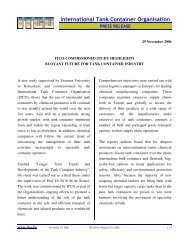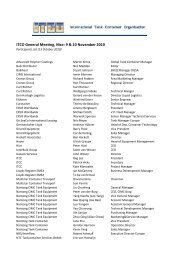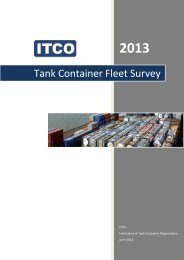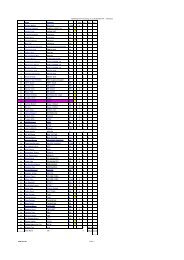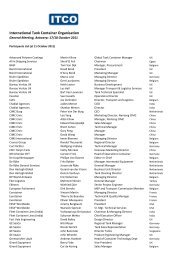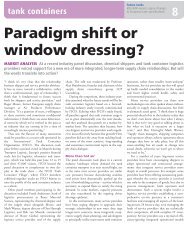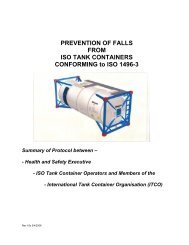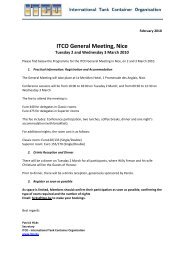You also want an ePaper? Increase the reach of your titles
YUMPU automatically turns print PDFs into web optimized ePapers that Google loves.
ICHCA International <strong>Safe</strong>ty Panel Briefing Pamphlet No 30<br />
6.3.2.1 As stated in paragraph 5.3.6 spill boxes are fitted with a drain tube to allow<br />
waste material to be drained. However it is important to note that liquids<br />
escaping from these tubes are not always dangerous. There have been a<br />
large number <strong>of</strong> false alarms raised because operators erroneously believed<br />
that the tank container was leaking. However on closer examination the<br />
liquid was found to be melt or rain water.<br />
6.3.3 Cryogenic <strong>Tank</strong>s<br />
6.3.3.1 Cryogenic tanks do not have any refrigeration equipment but rely on the<br />
vacuum insulation to reduce heat gain and retain the gaseous cargo in a<br />
liquefied state. All such tanks have a maximum “holding time”, a maximum<br />
time from filling before heat gain from ambient sources causes a pressure<br />
rise sufficient to open the pressure relief valves. The “holding time” will<br />
vary from tank to tank and should be made know to handlers and vessel<br />
operators as exceeding the holding time can be dangerous.<br />
6.3.4 <strong>Tank</strong> Container Heating<br />
6.3.4.1 If steam heating is being undertaken, it is essential that suitable precautions<br />
are taken to prevent anyone being scalded.<br />
Each steam coil is designed to a specific maximum pressure.<br />
Pressure should never be introduced into a steam coil in excess <strong>of</strong> its<br />
maximum pressure rating as there will be a risk <strong>of</strong> frangible the steam<br />
coil and even causing serious damage to the tank shell.<br />
6.3.4.2 Electrically heater tank containers do not have their own power source so<br />
that a power cable has to be plugged into an external power source.<br />
Most tank containers have a power cable but there is no standard<br />
length for the cable.<br />
It may be that extension cables have to be supplied to reach the power<br />
point. Care must be taken that these are in good condition and <strong>of</strong> the<br />
appropriate power rating.<br />
Most electrical systems are designed for operation from a 380 Volt<br />
three phase supply, usually 32 amps. It is important to ensure that only<br />
the correct voltage and amperage power source is used.<br />
Only the correct plug and socket should be used.<br />
7 Documentation<br />
7.1 When goods are <strong>of</strong>fered for transport, shippers have to prepare documentation<br />
suitable for the modes <strong>of</strong> transport and the type <strong>of</strong> the cargo. The form <strong>of</strong> these<br />
documents, the particulars to be entered on them and the obligations they<br />
entail may be fixed by international and national conventions, legislation,<br />
regulations and rules which apply to the different modes <strong>of</strong> transport.<br />
7.2 As it would be impossible for this pamphlet to cover all these requirements<br />
individuals should make themselves aware <strong>of</strong> their local legislation, statutory<br />
instruments and regulations.<br />
7.3 Documentation does not preclude the use <strong>of</strong> electronic data processing (EDP)<br />
and electronic data interchange (EDI) transmission techniques as an aid to, or<br />
in some cases in lieu <strong>of</strong>, paper documentation.<br />
7.4 The examples shown in Annex 4 are intended to provide guidance <strong>of</strong> the detail<br />
required.<br />
Page 26 ©ICHCA International Limited



